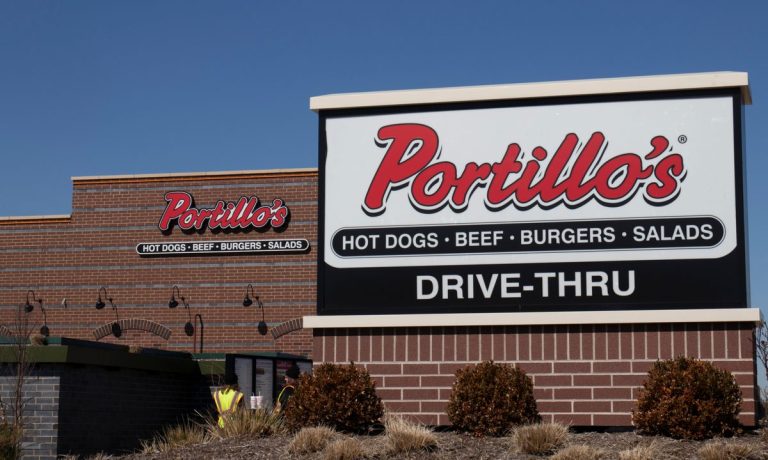
Where in the early months of the restaurant industry’s digital shift, online and physical purchasing channels remained largely separate, today digital technologies are transforming restaurants’ physical spaces. The rise of online, off-premise ordering is prompting brands to unveil smaller concepts with less seating space and to open new drive-thru lanes for mobile orders.
Portillo’s, the Illinois-based hot dog chain with about 70 locations across nine states, announced earlier this month that it will be opening its first Portillo’s Pick Up store Tuesday (Feb. 1), an off-premise-only location with a three-lane drive-thru and a digital order pickup area.
“We think we’re going where the puck is going, which is fewer diners eating inside of a restaurant and more using drive-thru, ordering ahead and picking up, so this is our first-ever attempt at a dining-room-less experience, and for Portillo’s, that’s a big deal,” Portillo’s Senior Vice President of Marketing and Off-Premise Dining Nick Scarpino told PYMNTS in an interview. “This is our first triple lane, and that third lane will be exclusively for pre-orders, order-ahead mobile web orders. So, we’ll see what happens.”
The news comes as many brands pivot their growth pipeline to include digital-order-centric locations. Quick-service restaurant (QSR) chain Del Taco announced Jan. 19 the opening of its first Fresh Flex store, which includes pickup lockers for digital orders and drive-thru lanes for mobile ordering and delivery driver pickup, among features.
Read more: Del Taco Opens Off-Premise-Focused Store Format
The previous week, Shake Shack and TGI Fridays both announced their own models that limit seating in favor of increased off-premise fulfillment capabilities.
See more: Brands Turn to Off-Premise Formats to Boost Profit Margins
Let’s Get Digital
Where once it was not clear whether the digital ordering boom would prove to be a short-term measure for consumers to enjoy their meals while complying with social distancing norms and regulations, the trend has now proven sticky, with insiders predicting that digital ordering will only continue to make up a greater share of total orders in years to come.
“This [digital shift] has been happening to us for many years, and fuel has been poured on that fire since the pandemic,” said Scarpino. “We think that this trend is going to continue, and we’re trying to lean into it and see what we can learn.”
Findings from PYMNTS’ 2021 How We Eat Playbook, created in collaboration with Carat from Fiserv, revealed that 43% of consumers are now ordering online for delivery more often than they were prior to the start of the pandemic. Additionally, the study, which drew from a census-balanced survey of more than 5,200 U.S. adults, found that consumers now are 31% more likely to buy meals for delivery or pickup than they are to dine on-site.
Read more: Restaurants and Grocers See Path to Picking up 200 Million New Customers
The channel also proves more profitable, since consumers use digital channels for group orders such as family meals more often than traditional channels.
“Consistently since we’ve had online ordering, the checks are materially higher every single time,” Scarpino said.
Tell It to Me Straight
One technology that Portillo’s is looking forward to implementing in the future is voice ordering. As some restaurant brands look to voice technology to automate the drive-thru, Portillo’s remains primarily focused on using it for own-device ordering.
“More and more when we watch people interact with their devices, it’s voice,” Scarpino said. “It’s sometimes the primary way that people are interacting with their devices.”
The demand for voice commerce capabilities in the food and beverage space is not overwhelming, but it is significant and growing. The How We Eat Playbook found that 6% of consumers who order restaurant meals and groceries online said they already use voice assistants to shop and pay, and 14% would like to do so going forward.
Cutting out the Middleman
With the growing share of total orders that digital channels are coming to occupy, Portillo’s, like many restaurants, is now focused on incentivizing customers to adopt its direct ordering channels, which are more cost-effective for the brand, allow the brand to gain valuable insight into its customers’ behaviors, and enable direct communication and messaging.
“We continue to see the popularity of third-party delivery apps — they are our partners, but they’re partners who know that forever we will be trying to drive direct digital orders, and that will always be our first priority,” said Scarpino.
While Portillo’s is an outlier in that it does not attempt to drive direct ordering through a loyalty rewards program, the brand does incentivize adoption through direct-channel-exclusive menu items and lower menu prices, among other initiatives.
Findings from the October edition of PYMNTS’ Digital Divide study, “Aggregators: The Cost Of Convenience,” created in collaboration with Paytronix, revealed that 44% of consumers had ordered online through their favorite restaurant’s direct ordering platforms in the previous three months, and 17% had ordered from their favorite restaurant through an aggregator. Additionally, the study, which surveyed a census-balanced panel of more than 2,200 U.S. adults, found that the most popular reason for ordering from channels other than aggregators was a desire for lower costs.
Get the report: The Digital Divide, Aggregators
“The value of having a direct relationship with the customer — it sometimes goes beyond just the P&L statements,” Scarpino said. “Having a one-to-one relationship with guests for a long time is massively important, and it would almost be impossible to understate that value.”